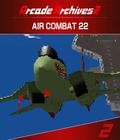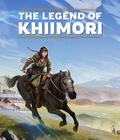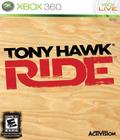Tony Hawk: Ride, appearing like the usual PS3 game bundled with the recently popular specialty controller, takes a somewhat different approach to presenting a contemporary AAA HD title. Graphically, the game is more reminiscent of Jet Set Radio Future than a recent installment in the Call of Duty series. Comparisons between the skateboard controller and various Wii games are unavoidable, but they won't hold water for very long. This is a very particular controller with a singular purpose: to control Ride, unlike the multipurpose Wiimotes.
The controller, taken by itself as a peripheral piece of gaming hardware, is surprisingly well constructed. It really shouldn't come as much of a surprise. It simply must be well-made gear: The board is weight-rated at 300 pounds. When you consider the athleticism required to play Ride, that's probably a ridiculous tolerance for anyone much shorter than seven feet. It does mean that a 200-pound gamer in decent shape can thrash around on the board a good bit without damaging it.
The Ride board approximates in shape, feel and heft a middle-quality board, minus trucks and wheels. The necessary controller face buttons are arrayed in a line along one side of the board, recessed but not outfitted with a cover panel. The face buttons are sturdy and responsive, though in-game they're not used. Indeed a lot of menu function can be controlled riding the board just as you would while playing the game (face-button alternatives are always provided as concurrently available options for menu selection). The board is wireless, battery-operated by included disposable AA cells, and communicates with the PS3 via a small USB receiver box. The game's controller translates players' movements — a fairly sophisticated range of movements for something you stand on — via accelerometers and a suite of motion sensors distributed around the edge of the board.
If you're the experimenting sort, you'll quickly discover you can achieve all sorts of in-game accolades just by picking up the board and prancing around the room. Shocker! You can cheat at a game. The point is that in this Wii era, no one should be surprised that there are ways to fool a video game via its unique control scheme so that you earn undeserved points and complete challenges without doing the things you're required to do by the game's design.
Further, cheating at sports and games is as old as the competitive pastimes themselves. Tony Hawk: Ride fairly takes no more heat for being susceptible to cheating than chess or baseball or Gears of War 2. Cheating is not the only way to succeed at this game; there's always effort and practice to fall back on. The degree to which you want to invest lots of time in either of those things to play Ride well is a personal choice; but if you'll put 1,000 hours into Rock Band, it's not asking too much you do it here, too, if extreme sports games are your thing.
The game's introduction is a somewhat protracted board calibration exercise video tutorial, instructed by Tony Hawk himself. Besides being a bit overlong, calibration is simple. The video indicates calibration is not required every time you play, only after battery swaps and the like. In my experience, it can't hurt to run through the calibration process every 10th or 15th time you play, although it is probably unnecessary, as the tutorial describes. I would, however, recalibrate the board before switching to higher difficulty levels.
Tony Hawk: Ride's gameplay is focused around the Road Trip mode, in which you travel around to new skating locations filled with new challenges. Completing those location-based challenges earns points. Via this common manner of sports game progression, you unlock more skating locations. Once a location has been unlocked, you may replay it to your heart's content, for better scores, practice or pure entertainment. Challenges consist of the usual tricks available in any modern skateboarding game: ollie into jumps, grind rails, perform grabs and kick flips, etc. Of course, in this game, you're using the approximation of a real skateboard to pull off the tricks. As mentioned, if you pick up the board and flip it around, you'll do some things you're meant to, and a lot of things you're not. If you leave the board on the floor under your feet, where it belongs, you'll have to learn how to pull off the tricks.
Casual mode is the only place to start, even for seasoned skaters. I'd say Ride will immediately put off seasoned skaters who jump right into Hardcore or even Confident mode. Start at Casual, which provides a guided line both on-screen and in gameplay mechanics; you won't navigate the locations much at first, but the game will guide you from trick to trick. Freely navigating the locations is best saved until after you've put in quite a few hours adjusting to the board, even if you're an extreme sports competition skater. Ride is a simulator, but it's a skateboarding simulation for home game consoles, not a flight simulator for Air Force F-16A pilots. Mechanically, the title has far more in common with real skateboarding than standard-controller efforts, but it's still its own beast and should be treated as such. The greatest benefit real-world skaters will have in playing Ride is general fitness, endurance in the legs and perhaps ankle strength.
The greatest shortcomings to the board controller are pedaling, and maneuvers you'd normally perform in the air or at speed. You're never in the air and you're never moving forward or backward, requiring you exaggerate various movements that in real skateboarding are far more subtle yet yield greater effect on your skating. There is some natural feedback from balancing the board tipped back with its nose high in the air, but this is not nearly the same sort of physical feedback you get while clipping along over concrete, spending brief moments in the air. Learning to balance on the Ride board during all the maneuvers the game expects is the biggest hurdle to overcome in enjoying the game. As for pedaling, there is no particular problem with the scheme other than it doesn't feel right pedaling and going nowhere, save in an on-screen representation. The game is designed so that lots of pedaling is not required; a single good kick will get your in-game skater rolling in the right direction — and if you hit most of the tricks or even come close, you'll sustain that virtual momentum.
Finally, there's the issue of athleticism. You don't have to be a marathoner to play Tony Hawk: Ride, but it couldn't hurt. Ride is not much of an aerobic exercise, but if you've little strength and conditioning of your leg muscles and ankles, you'll need to condition them playing the game before you're reasonably comfortable. I cycle at least 60 miles a week, and I've done that for years, but though I had a far easier time starting out than even my featherweight, reasonably fit teen daughter, I felt the strain on my ankles and calves. The best combination of prerequisite athletics for playing Ride is likely avid cycling and regular ice skating, which aren't a typical combination of sports so almost everyone should expect a fair bit of conditioning time (yes, even you real-world start skaters). You're working different muscles in a mostly stationary simulation than you are out at the park on a real board. The game's location events are broken up into quite short runs, a few minutes at most, helping to create rest breaks where there otherwise would be no natural breaks — but be prepared for some real physical stress while playing.
I've spent a lot of time herein on the board controller, and not so much evaluating the game itself. There's good reason for that: The controller is the game. That's the hook, and, really, the only compelling element. The game is thoroughly competent, has a nice graphical style, better than average audio, and a good, sometimes great, licensed soundtrack, but Ride without the board controller, even if you could play it without the board, won't turn any heads. The issue of price, at $120, is like the DJ Hero title from the same publisher. It's only a concern until you feel the build quality of the peripheral. I'm sure Activision is making nice margins on both bundles, but they're not shortchanging the gamer, either. The board is constructed to last, even with heavy play.
DJ Hero and Tony Hawk: Ride have a great deal in common for two such apparently different games. They're both very simulative of the real-world endeavors they represent, but neither DJ Hero nor Ride are actual trainers for the skills required to perform either thing. Tony Hawk: Ride may condition your lower-leg muscles, improve ankle strength and give you a solid feel for some skating maneuvers. You'll probably pick up some of the fundamental concepts of skating. It may intrigue you enough that you'll make a serious effort to learn real skating. But the game is not going to teach you how to skate any more than DJ Hero will teach you how to creatively sync and mix beats, though you can learn some of the fundamentals in that game, too. Certainly don't expect to hit the local park or parking lot an intermediate star after 40 hours playing Ride.
There's also both a fairly steep learning curve and a significant conditioning curve, and you can definitely cheat the game with relative ease. If you're put off by any of those issues, save your money. Otherwise, Ride is a good value, all things considered, founded upon a competent game and an evolutionary step in motion-controlled gaming. If you're interesting in skating, you have at least a moderate athletic streak, you're willing to put in the training time, and you're looking for a game different than the Wii Sports variety to get you up off the sofa, you'll likely find Tony Hawk: Ride a treat.
Score: 8.0/10
More articles about Tony Hawk: Ride











 For the first time, players will have the ability to physically play the game using an innovative motion sensing skateboard controller, allowing for unprecedented freedom and movement. Tony Hawk: Ride focuses on innovation and fun, bringing the action-sports franchise to the forefront with cutting-edge technology for the hardcore fans and accessibility for the mass audience.
For the first time, players will have the ability to physically play the game using an innovative motion sensing skateboard controller, allowing for unprecedented freedom and movement. Tony Hawk: Ride focuses on innovation and fun, bringing the action-sports franchise to the forefront with cutting-edge technology for the hardcore fans and accessibility for the mass audience.














































